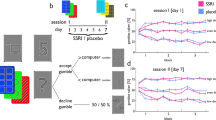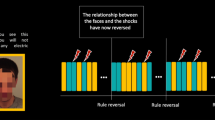Abstract
BLEULER has described stereotyped behaviour as “one of the most striking external manifestations of schizophrenia”1. Schizophrenic stereotyped behaviour has been found in the spheres of movement, action, posture, speech, writing, thought aid desire1. Abuse of the psychomotor stimulant drugs, such as the amphetamines, methylphenidate, cocaine and pipradrol, can cause a psychosis which is clinically indistinguishable from paranoid schizophrenia2, and which contains stereotyped components2,3. In animals, acute doses of the stimulants can induce stereotyped behaviour which is apparently under minimal situational control, and which can disrupt normal activity4. In contrast, low doses of the stimulants can apparently improve learning and performance in a variety of situations, in both animals5 and man6. This paper demonstrates a relationship between these two apparently diverse actions.
This is a preview of subscription content, access via your institution
Access options
Subscribe to this journal
Receive 51 print issues and online access
$199.00 per year
only $3.90 per issue
Buy this article
- Purchase on Springer Link
- Instant access to full article PDF
Prices may be subject to local taxes which are calculated during checkout
Similar content being viewed by others
References
Bleuler, E., Dementia Praecox, 185–190 and 454–455 (International Universities, New York, 1950).
Snyder, S. H., Arch. gen. Psychiat., 27, 169–179 (1972).
Rylander, G., in Correlation of Adverse Effects in Man with Observations in Animals (edit. by Baker, S.), 28–31 (Excerpta Medica, Amsterdam, 1971).
Randrup, A., and Munkvad, I., J. psychiat. Res., 11, 1–10 (1975).
Lyon, M., and Robbins, T. W., in Current Developments in Psychopharmacology, 2 (edit. by Essman, W., and Valzelli, L.), 79–163 (Spectrum, New York, 1975).
Weiss, B., and Laties, V. G., Pharmac. Rev., 14, 1–36 (1962).
Stein, L., in Animal Behaviour and Drug Action (edit. by Steinberg, H., de Reuck, A. V. S., and Knight, J.), 91–118 (Churchill, London, 1964).
Hill, R. T., in Amphetamine and Related Compounds (edit. by Costa, E., and Garattini, S.), 781–795 (Raven, New York, 1970).
Robbins, T. W., Psychopharmacologia, 45, 103–114 (1975).
Berlyne, D. E., in Nebraska Symposium on Motivation (edit. by Levine, D.), 1–110 (Univ. Nebraska, Lincoln, 1967).
Dews, P. B., J. Pharmac. exp. Ther., 122, 137–147 (1958).
Mackintosh, N. J., The Psychology of Animal Learning (Academic, London, 1975).
Winer, B. J., Statistical Principles in Experimental Design, 399 (McGraw-Hill, New York, 1971).
Kiernan, C. C., Psychopharmacologia, 8, 23–31 (1965).
Longstreth, L. E., in Nebraska Symposium on Motivation (edit. by Cole, J. K.), 38–80 (Univ. Nebraska, Lincoln, 1971).
Ellinwood, E. H., Psychopharmacologia, 21, 131–138 (1971).
Hutt, C., and Hutt, S. J., in Behaviour Studies in Psychiatry (edit. by Hutt, S. J., and Hutt, C.), 175–200 (Pergamon, Oxford, 1970).
Henderson, D., and Gillespie, R. D., Textbook of Psychiatry, tenth ed. (revised by Batchelor, I.R.C.), 277–278 (Oxford, London, 1969).
Author information
Authors and Affiliations
Rights and permissions
About this article
Cite this article
ROBBINS, T. Relationship between reward-enhancing and stereotypical effects of psychomotor stimulant drugs. Nature 264, 57–59 (1976). https://doi.org/10.1038/264057a0
Received:
Accepted:
Issue Date:
DOI: https://doi.org/10.1038/264057a0
This article is cited by
-
Comment on Vandaele and Ahmed: Rethinking habits in addiction
Neuropsychopharmacology (2021)
-
Methylphenidate and impulsivity: a comparison of effects of methylphenidate enantiomers on delay discounting in rats
Psychopharmacology (2014)
-
Deletion of the GABAA α2-subunit does not alter self administration of cocaine or reinstatement of cocaine seeking
Psychopharmacology (2014)
-
Comparison of the conditioned reinforcing properties of a safety signal and appetitive stimulus: effects of d-amphetamine and anxiolytics
Psychopharmacology (2013)
-
Effects of pramipexole on the reinforcing effectiveness of stimuli that were previously paired with cocaine reinforcement in rats
Psychopharmacology (2012)
Comments
By submitting a comment you agree to abide by our Terms and Community Guidelines. If you find something abusive or that does not comply with our terms or guidelines please flag it as inappropriate.



